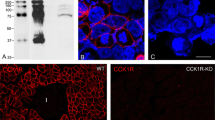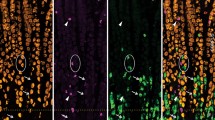Summary
An immunohistochemical study has been performed to analyse the distribution of gastrin cells in the gastrointestinal tract of the dog. This study revealed that G-cells immunoreactive for gastrin were almost exclusively present in the pyloric antral mucosa, mainly in the middle third of the pyloric mucosa. The calculated number of G-cells per surface unit area was 8.5×103–1.2×104 cells cm−2. Some gastrin-immunopositive cells were found in the first 10 mm of the proximal duodenum, mainly in the villous region. The fundic area of the dog stomach, the oesophagus, small intestine, caecum, colon, rectum, salivary glands, liver and pancreas were all immunonegative for gastrin. At the ultrastructural level, three different types of granules (150–400 nm) were evident in G-cells: electron-dense, electron-lucent and intermediate forms. Most of them were located in the subnuclear region of the cell. The effect of fixation of the antral mucosa at different pH levels was studied. In samples fixed with acid solutions, most of the G-cell granules were of the electron-dense type and were stronly immunopositive for gastrin. Fixation of samples at a basic pH resulted in most of the gastrin granules losing their contents into the cytoplasm, and the positive reaction to gastrin was then located in the cytoplasm and at the periphery of the electron-lucent granules.
Similar content being viewed by others
References
Becker, H. D., Reeder, D. D. &Thompson, J. C. (1973) The effect of changes in antral pH on the basal release of gastrin.Proc. Soc. Exp. Biol. Med. 143, 238–40.
Ceccarelli, P., Pedini, V. &Gargiulo, A. M. (1995) The endocrine cells in the gastro-enteric tract of adult Fallow Deer (Dama dama L.).Anat. Histol. Embryol. 24, 171–4.
Dial, E. J., Cooper, L. C. &Lichtenberger, L. M. (1991) Amino acid- and amine-induced gastrin release from isolated rat endocrine granules.Am. J. Physiol. 260, G175–81.
Dickinson, C. J. &Yamada, T. (1986) Characterization of the carboxyl-terminal amidating enzyme in the gastrointestinal tract: comparison with the pituitary.Can. J. Physiol. Pharmacol. 64, 81–2.
Dickinson, C. J., Takeuchi, T., Guo, Y.-J., Stadler, B. T. &Yamada, T. (1993) Expression and processing of prohormones in nonendocrine cells.Am. J. Physiol. 264, G553–60.
Dockray, G. J., Dimaline, R., Forster, E. R., Evans, D., Sandvik, A. &Varro, A. (1993) Gastrin cell responses to acidification of the achlorhydric rat stomach.Am. J. Physiol. 265, G440–4.
Eipper, B. A., Myers, A. C. &Mains, R. E. (1985) Peptidylglycine alpha-amidation activity in tissues and serum of the adult rat.Endocrinology 116, 2497–504.
Elwin, C. E. (1960) The influence of antral pH on gastric secretion in dogs stimulated by antral perfusion with different agents.Acta Physiol. Scand. 50, 36–7.
Forssmann, W. G. &Orci, L. (1969) Ultrastructural and secretory cycle of the gastrin-producing cell.Z. Zellforsch. Mikrosk. Anat. 101, 419–32.
Franco, A., Regodon, S., Gazquez, A., Masot, A. J. &Redondo, E. (1993) Ontogeny and distribution of gastrin cells in the gastrointestinal tract of the sheep.Eur. J. Histochem. 37, 83–90.
Galán, J. A. (1995)Estudio inmunocitoquímico de la gastrina en el perro. Determinación de sus variaciones fisiológicas en suero mediante radioinmunoensayo. Ph.D. Thesis, pp. 133–6. Madrid: Complutense University.
Graham, D. Y., Lew, G. M. &Lechago, J. (1993) Antral G cell and D cell numbers inHelicobacter pylori infection: effect ofH. pylori eradication.Gastroenterology 104, 1655–60.
Grossman, M. I. &Marks, I. N. (1960) Secretion of pepsinogen by the pyloric glands of the dog, with some observations on the histology of the gastric mucosa.Gastroenterology 38, 343–52.
Hakanson, R., Alumets, J., Rehfeld, J. F., Ekelund, M. &Sundler, F. (1982) The life cycle of the gastrin granule.Cell Tissue Res. 222, 479–91.
Hansen, C. P., Stadil, F. &Rehfeld, J. F. (1995) Metabolism and influence of gastrin-52 on gastric acid secretion in humans.Am. J. Physiol. 269, G600–5.
Helander, H. F. (1962) Ultrastructure of the fundus glands of the mouse gastric mucosa.J. Ultrastruct. Res. 4, 7–123.
Helander, H. F. (1964) Ultrastructure of secretory cells in the pyloric gland area of the mouse gastric mucosa.J. Ultrastruct. Res. 10, 145–59.
Ito, H., Yamada, J., Yamashita, T., Hashimoto, Y. &Kudo, N. (1987) An immunohistochemical study on the distribution of endocrine cells in the gastrointestinal tract of the pig.Jpn. J. Vet. Sci. 49, 105–14.
Kapur, S. P. (1982a) An ultrastructural and cytochemical study of enteroendocrine cells of the pyloric antrum in the gerbil,Meriones unguiculatus. Acta Anat. 112, 220–32.
Kapur, S. P. (1982b) A study of two enteroendocrine cells in the duodenum of the gerbil—Meriones unguiculatus.Acta Anat. 112, 97–104.
Kitamura, N., Yamada, J., Yamashita, T. &Yanaihara, N. (1982) Endocrine cells in the gastrointestinal tract of the cat.Biomed. Res. 3, 612–22.
Kitamura, N., Yamada, J., Calingasan, N. Y. &Yamashita, T. (1984) Immunocytochemical distribution of endocrine cells in the gastrointestinal tract of the horse.Equine Vet. J. 16, 103–7.
Krause, W. J., Ivey, K. J., Baskin, W. N. &Mackercher, P. (1977) Ultrastructure of the human pyloric glands with emphasis on the mucous cell component.Acta Anat. 99, 1–10.
Lichtenberger, L. M., Nelson, A. A. &Graziani, L. A. (1986) Amine trapping: physical explanation for the inhibitory effect of gastric acidity on the postprandial release of gastrin. Studies on rats and dogs.Gastroenterology 90, 1223–31.
Mortensen, N. J. M. &Morris, J. F. (1977) The effect of fixation conditions on the ultrastructural appearance of gastrin cell granules in the rat gastric pyloric antrum.Cell Tissue Res. 176, 251–63.
Oomori, Y., Tanaka, H., Iuchi, H., Ishikawa, K., Satoh, Y. &Ono, K. (1993) Effect of fixation conditions on the granule morphology of rat antral gastrin cells: an ultrastructural and immunocytochemical study,Acta Histochem. 1, 25–31.
Pawlikowski, M., Karbownik, M., Lewinski, A., Pisarek, H., Wajs, E. &Szkaudelinski, M. (1992) Effects of omeprazole on the number of immunoreactive gastrin and somatostatin cells in the rat gastric mucosa.Histol. Histopathol. 7, 153–6.
Rahier, J., Pauwels, S. &Dockray, G. J. (1987) Biosynthesis of gastrin. Localization of the precursor and peptide products using electron microscopic-immunogold methods.Gastroenterology 92, 1146–52.
Rehfeld, J. F. &Johnsen, A. H. (1994) Identification of gastrin component I as gastrin-71. The largest possible bioactive progastrin product.Eur. J. Biochem. 223, 765–73.
Solcia, E., Vassallo, G. &Sampietro, R. (1967) Endocrine cells in the antro-pyloric mucosa of the stomach.Z. Zellforsch. Mikrosk. Anat. 81, 474–86.
Solcia, E., Capella, C., Vassallo, G. &Buffa, R. (1975) Endocrine cells of the gastric mucosa.Int. Rev. Cytol. 42, 223–86.
Solcia, E., Capella, C., Buffa, R., Usellini, R., Fontana, P. &Frigerio, B. (1978) Endocrine cells of the gastrointestinal tract: general aspects, ultrastructure and tumour pathology.Adv. Exp. Med. Biol. 106, 11–22.
Tobe, T., Chen, S.-T., Henmi, K. &Fukuchi, K. (1976) Distribution of gastrin in canine, cat, and human digestive organs.Am. J. Surg. 132, 581–2.
Tominaga, K. (1975) Distribution of parietal cells in the antral mucosa of human stomachs.Gastroenterology 69, 1201–7.
Track, N. S., Creutzfeld, C., Arnold, R. &Creutzfeld, W. (1978) The antral gastrin-producing G-cell: biochemical and ultrastructural responses to feeding.Cell Tissue Res. 194, 131–9.
Varndell, I. M., Harris, A. &Tapia, F. J. (1983) Intracellular topography of immunoreactive gastrin demonstrated using electron immunocytochemistry.Experientia 39, 713–17.
Walsh, J. H. (1988) Peptides as regulators of gastric acid secretion.Ann. Rev. Physiol. 50, 41–63.
Walsh, J. H. (1993) Gastrointestinal hormones: past, present, and future.Gastroenterology 104, 653–7.
Walsh, J. H., Richardson, C. T. &Fordtran, J. S. (1975) pH dependence of acid secretion and gastrin release in normal and ulcer subjects.J. Clin. Invest. 55, 462–8.
Author information
Authors and Affiliations
Rights and permissions
About this article
Cite this article
Galán, J.A., Alonso, F.J.M., Moratinos, P. et al. The G-cells in the dog: a light and electron microscope immunocytochemical study. Histochem J 28, 883–893 (1996). https://doi.org/10.1007/BF02331392
Received:
Revised:
Issue Date:
DOI: https://doi.org/10.1007/BF02331392




